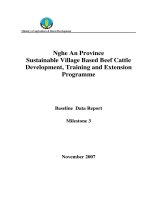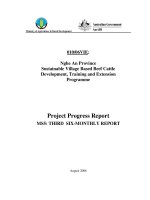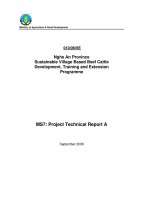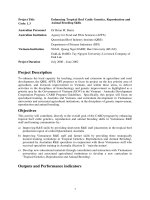Beef cattle
Bạn đang xem bản rút gọn của tài liệu. Xem và tải ngay bản đầy đủ của tài liệu tại đây (12.34 MB, 282 trang )
Table of Contents
Title Page
Dedication
Introduction
CHAPTER ONE - Beef Cattle: A Primer
OUT OF ASIA, INTO THE WILD WEST
BEEF CATTLE: THE BASICS
BEEF BREEDS
CATTLE BIOLOGY
HOOVES AND HIDE
HOW CATTLE SENSE THE WORLD
CATTLE BEHAVIOR
THE CATTLE PRODUCTION CYCLE
CHAPTER TWO - Before You Begin: Fences, Feed, and
Facilities
FENCES
OUT WITH THE OLD
IN WITH THE NEW
FEED
PASTURE
HAY
GRAIN
HANDLING FACILITIES
SHELTER, WATER, SALT, AND MINERALS
CHAPTER THREE - Choosing, Buying, and Bringing Home
Cattle
WHAT TO BUY
WHAT TO LOOK FOR IN CATTLE
SHAPE
HEALTH
HOW CATTLE ARE PRICED AND SOLD
WHERE TO BUY CATTLE
BRINGING CATTLE HOME
CHAPTER FOUR - Feeding Beef Cattle
PASTURE
PASTURE QUALITY
ROTATIONAL VERSUS EXTENSIVE GRAZING
GRAZING MANAGEMENT BASICS
HAY
WHEN TO BUY OR HARVEST
WINTER HAY FEEDING
GRAIN
FEEDING DAIRY CALVES
FINISHING RATIONS
GRASS-FINISHING
WATER
SALT AND MINERALS
CHAPTER FIVE - Handling Beef Cattle
CATTLE HANDLING FUNDAMENTALS
ESTABLISHING A ROUTINE
GETTING READY FOR HANDLING DAYS
HANDLING DAYS
LOADING AND TRANSPORTING CATTLE
AFTER HANDLING DAYS
CHAPTER SIX - Keeping Beef Cattle Healthy
PREVENTION
BALANCED DIET, EXERCISE, AND SHELTER
VACCINATIONS
INTERNAL PARASITES
EXTERNAL PESTS
RECORDKEEPING AND ANIMAL IDENTIFICATION
HOW TO TELL WHEN AN ANIMAL IS SICK
WHAT TO DO WHEN AN ANIMAL IS SICK
CHAPTER SEVEN - Breeding Beef Cattle
CHOOSING COWS AND HEIFERS
BREEDING COWS AND HEIFERS
ARTIFICIAL INSEMINATION
USING A LIVE BULL
COMBINING AI AND LIVE BULL METHODS
CARE AND FEEDING OF PREGNANT COWS
CALVING
WHEN TO INTERVENE
TAKING CARE OF NEWBORN CALVES
CASTRATION
DEHORNING
WEANING CALVES
REBREEDING COWS
CHAPTER EIGHT - Marketing and Processing Your Cattle
SELLING AT AUCTION
GRADE AND YIELD
GETTING YOUR BEEF PROCESSED
SELLING BEEF FROM THE FARM
TRANSPORT AND SHRINKAGE
Acknowledgments
Appendix: - A Glance at Beef Cattle Afflictions
Glossary
Resources
Index
ABOUT THE AUTHOR
Copyright Page
This book is dedicated to my husband, Steve, and our sons,
Nick, Phil, and Joe:
Thanks for making it possible, and thanks for making it fun.
INTRODUCTION
Why Beef Cattle?
Beef cattle are as much at home on the hobby farm as they
are on the range. Adaptable to almost any climate and easy
to manage and to market, they are well suited to any farmer
with the pasture room and a hankering for a cowboy hat.
Although beef cattle require a higher initial investment than
any other traditional farm animal, except dairy cows, they
require the least amount of daily maintenance.
Attention to the basics of raising beef cattle will reap
rewards in the form of a freezer full of homegrown beef as
well as extra cash from meat and calf sales. Where cattle are
common, so are the auction barns, processing plants, and
truckers that make it fairly simple to buy, sell, and process
cattle. Americans love beef, so there is a ready market for
beef cattle.
There’s another benefit to owning beef cattle: they can
improve your land. This may come as a surprise, given the
reputation cattle have acquired in certain quarters for
overgrazing and destroying sensitive lands. But beef cattle
are a tool, not a cause. The result depends on how the tool is
wielded—just as a hammer can be used to fix a building or to
wreck it. Research and on-the-ground experience have
demonstrated that, when properly managed, beef cattle can
be a highly effective tool for restoring health to damaged
grasslands and watersheds. On a hobby farm, well-managed
beef can continually increase the richness of your soils, the
biodiversity and lushness of your pastures, and the water
quality of your ponds and streams.
Beef cattle will also enhance the view from your kitchen
window. Every time I look out the window to see our cattle
grazing the green slopes of our farm, hear bobolinks singing
in our pasture, or prepare homegrown steaks for dinner, I’m
glad we have beef!
CHAPTER ONE
Beef Cattle: A Primer
Understanding the basics of cattle evolution, biology, and
behavior can provide valuable insight into selecting the right
cattle for your farm and caring for your new livestock.
Here’s a brief history of cattle and an overview of cattle
types, breeds, and traits.
OUT OF ASIA, INTO THE WILD WEST
Bos primigenius, the massive ancestor of all modern cattle,
stood up to six feet tall at the shoulder and wielded a
spectacular set of horns, with a tip-to-tip span of up to ten
feet. Herds of these wild prehistoric bovines—or aurochs as
they’re commonly called—roamed throughout North Africa
and most of Europe and Asia, following the melting glaciers
of the last Ice Age northward. Between 500,000 and 750,000
years ago, long before humans appeared on the scene, the
intimidating aurochs split into two distinctive subtypes, the
taurine and indicine (or typicus and indicus) varieties of
cattle. The humped, droopy-eared indicus multiplied in the
eastern portions of the aurochs’ range, while the humpless
taurine, whose ears stand out at the sides rather than flop,
spread through the Middle East, northern Africa, and
Europe. Their domesticated descendants are the droopyeared indicus breeds that dominate Asia and are popular in
the southern United States as well as the familiar taurine
breeds that are common throughout Europe and North
America.
Probably because they were so large, well armed, and
willing to defend themselves, aurochs were rarely hunted by
early humans and were domesticated after goats, sheep, and
pigs were. But humans seem to have learned early on to love
the taste of beef despite the difficulty of obtaining it.
Eventually, they figured out that it was easier to raise, than
to hunt, cattle and became ranchers. Cattle bones found in
archaeological digs in southwestern Turkey show that
between eight thousand and seven thousand years ago, the
taurine-type cattle eaten by ancient villagers began
decreasing in size, evidence of domestication. These early
ranchers clearly selected small, docile animals less likely to
charge their owners or disappear in the middle of the night.
A pair of bulls carts hay through downtown Weymouth, Nova
Scotia, in this old photo. Cattle have historically been used
as draft animals as well as sources of meat and leather.
While Middle Eastern farmers appear to have been the
first to domesticate cattle, farmers elsewhere probably did
so not long after. Many researchers believe indicus-type
cattle were domesticated separately in Asia. A more
controversial theory argues that taurine-type aurochs were
also domesticated separately, by North Africans, and later
mixed with immigrant indicus to give rise to the distinctive
sanga cattle breeds of Africa.
Early Middle Eastern farmers used cattle solely for meat
and leather and kept far fewer cattle than they did sheep
and goats. When humans began migrating into the heavily
forested and much colder regions of northern Europe, they
quickly found themselves much more dependent on cattle.
On the move north, goats could not pack as many of their
owners’ possessions on their backs as cattle could, and once
people arrived in the new land, neither sheep nor goats were
of much use in clearing forests or pulling plows in the heavy
soil. As farming spread north, cattle—which are not fussy
eaters and not overly bothered by predators and actually
seem to like the cold—quickly became the most important
livestock species. Oxen (castrated adult male cattle) became
northern Europe’s primary source of transport and farm
power. They remained so until about two hundred years ago,
when horses and then the internal combustion engine took
their places in most regions.
By three thousand years ago, cattle keepers from Egypt to
England had figured out that a cow that pulled a plow or a
cart could also furnish milk for the family. Thus the dualpurpose cow and the dairy industry were born. Cows and
oxen no longer able to work provided their owners with a
large amount of highly nutritious and palatable beef and
hides for leather goods.
When English and Dutch settlers brought their cattle to
North America in the early 1600s, they adapted their ways of
keeping cattle to their spacious new environment. All along
the East Coast, cattle not needed for milk or labor were
turned into the woods for the summer and rounded up in the
fall. Each animal had its ear notched in a way particular to
its owner, who had to register his brand with the town
officials. In the fall, excess cattle were assembled in herds
and a drover hired to walk them to the freshmeat markets in
big towns such as Boston and Philadelphia.
Did You Know?
Domestic cattle, which belong to the genus and species
of Bos taurus, have no wild siblings. The last known
wild aurochs, or Bos primigenius, a cow, died in Poland
in 1627. Other members of the bovine group are bison
and yaks. Sheep, goats, and pigs are more distantly
related, belonging to the same family, Bovidae, as
cattle.
Young Herefords fatten up on alfalfa hay in a California
feedlot.
Beef cattle need lots of pasture, and as human settlers
multiplied, unclaimed land became scarce. Beef cattle
producers pushed farther and farther west in search of the
necessary cheap grazing. This made for a longer walk to
market in the fall, resulting in skinny cattle. Since fat is what
makes beef taste good, a finishing industry grew up near the
meat processors, where the cattle could be penned and
fattened. As the corn belt of the Midwest developed in the
nineteenth century, cattle coming from summer grazing
farther west were fattened on excess corn there through the
winter and driven farther east to market in the spring. In the
1870s, railroads and then refrigerated railcars reached the
Midwest, and the beef processing industry found it more
expedient to process cattle in nearby towns, such as
Chicago, then ship the finished products to the East Coast,
than to ship live cattle.
By the time of the Civil War, the center of beef cattle
production—the cow-calf operations that produced the
young cattle for finishing—was moving into the Great Plains,
where the herders mounted horses and became cowboys.
The cows they herded were Longhorns, left behind by the
thousands when their owners, from the Spanish missions
and haciendas of Texas and California, left for Mexico after
the Texas Revolution of 1836. Most Americans think of
westernstyle ranching as uniquely American, but it really
began with the Spanish colonists and their Mexican
vaqueros, the first cowboys.
Near Paisley, Oregon, a cowboy drives a herd from summer
range to winter pasture. Cowboys on horseback still move
cattle in some parts of the country, especially out west,
where the terrain can be rugged and the distances long.
During the Civil War, many cowboys and ranchers joined
the military and headed east, leaving the cattle to fend for
themselves. While eastern herds were decimated by hungry
soldiers and civilians, the western Longhorns ran wild and
multiplied. When the war ended, there weren’t enough cattle
left in the East to satisfy demand, let alone supply the wave
of soldiers and miners now moving west, and by 1866, beef
cattle prices were 200 percent higher than they had been
before the war.
Texas rancher Charlie Goodnight returned from the war to
find that the 180 head of cattle he’d left behind had grown to
5,000 grazing in the area. Although the cattle weren’t worth
much in Texas, reports were trickling back of Longhorns
bringing an incredible $40 per head in the right market,
including the Northwest. In the Northwest, the U.S. Army
had forts full of soldiers in need of food and far from any
food sources. Goodnight looked up his friend and veteran
cattleman Oliver Loving to help, and they rounded up two
thousand head of cattle. The pair hired eighteen riders and
headed north, edging the Chihuahua desert, crossing rivers,
fighting Indians, and turning stampedes. At Fort Sumner in
New Mexico Territory, the herd was sold to government
provisioners. Goodnight netted the princely sum of $12,000,
and the golden age of cowboys and cattle drives was born.
Cattle were king.
Did You Know?
Historically, the term cattle was used to refer to all
varieties of four-legged livestock, including horses,
goats, and sheep. When referring specifically to
bovines, ranchers used the term neat cattle. Only in
the past 100 to 150 years has the meaning of the word
cattle changed to refer only to domesticated bovines of
the Bos genus.
Cattle in Myth and History
Cattle stampede across the 5,500-year-old cave
paintings at Tassili n’Ajjer in Algeria, pull a cart in a
2,600-year-old
bas-relief
from
Nineveh
in
Mesopotamia, and power a plow in a 1,750-year-old
Roman tile mosaic from Saint-Romain-en-Gal in
France. Clearly, cattle have been an integral part of
human lives, art, and culture in North Africa, the
Middle East, Asia, andurope for a long, long time.
Not only have humans used cattle for labor, milk,
and meat, but they have also counted the animals as
wealth and status and have revered them in myths
and religious beliefs.









